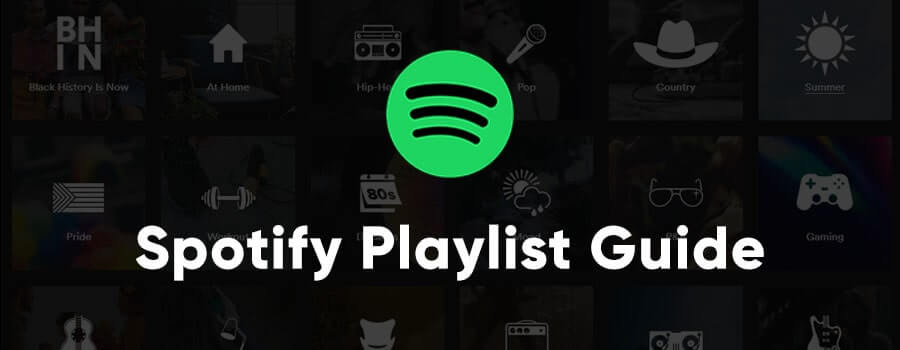
In this modern digital age, streaming has become the primary way for us to discover, listen, and share new music. For musicians, this accessibility has allowed their songs to be discovered by new potential fans from all over the world.
One of the ways to reach new fans is through Spotify playlists.
Spotify playlists can potentially put you in front of the right people who are more likely to be into your music and turn into proper fans.
As an independent artist, it’s important to understand how Spotify works and how its playlist system can bridge the gap between you and potential fans.
However, the climate for streaming platforms like Spotify has become highly competitive, so just uploading your song will not be enough. Keep in mind that over 100,000 new songs are added to Spotify each day!
In this blog, I will go over the different types of Spotify playlists as a discovery tool to help you get more exposure for your music.
Why Spotify Playlists?
Spotify is the dominant music streaming platform with 602 million active users worldwide reported in 2023. As of April 2024, 236 million are subscribed to Spotify Premium.
Its main competitor, Apple Music, has only 92 million paid subscribers in 2024.
I’m solely focusing on Spotify in this blog because the playlist system they created gives you more opportunities for placement and exposure, which is what we are looking for.
There are thousands of playlists on Spotify that can be right for you and can help your song perform better on the platform.
Disclaimer: The Problem With Playlisting
Some may have this misconception that getting on the right playlist is all you need to be successful. At the moment, developing a profitable business model based primarily on streaming/playlisting is not possible for most. According to Spotify’s Loud & Clear report in 2023, 50,000 artists (out of over 10 million) generated at least $16.5K from Spotify.
I want to remind you that playlists are vehicles for exposure and discovery. It’s rare for even a major label artist to make a sustainable living off streaming alone.
As most people are aware of by now, streaming services don’t pay artists well. 1,000 streams pay you roughly $4 – $6 depending on the platform.
For a musician in the United States, this means that a stream is worth about $0.006 per song stream. To earn $12,000, which would be considered on the lower end of a decent income, you would need 3,000,000 streams a year.
With these low payout rates, you have to look at a Spotify playlisting strategy as a long term investment. If you spend $300 on social media ads to push a song on Spotify or you pay $500 for a playlist pitching service, don’t expect to make that money back in the short term. Most of the time, these paid efforts will result in a loss and you won’t see a return on investment.
These playlisting tactics may pay itself out down the line with a thought out plan, but don’t think of spending money towards Spotify playlisting as a way to profit off your music. In other words, even if you’re losing money, it’s not a total loss. You need to understand the specific benefits of investing in these Spotify tactics and how it fits within your overall goals and marketing plan.
With Spotify being the biggest revenue generator for the music industry, it is undeniable that they are a huge component of an artist’s career. With that being said, I will do my best to show you how to make the most out of with their playlist system.
Why Get On Playlists?
Getting on a playlist with a lot of activity and followers can help you be discovered by more people who have never heard of your music. It’s an opportunity to get more exposure, raise your brand awareness and build momentum for your career.
More specifically, getting on playlists will help your song’s performance in their algorithm and can lead to more exposure within Spotify in a way you may not be thinking about. Getting playlisted is an important signal for Spotify. They examine your song in relation to other songs on a playlist to better understand who may like your music. When people listen to the songs on the playlist, it collects this data to help make recommendations to other Spotify users.
Your main goal is to get more people to listen to your music, right? Spotify also uses listening behavior and engagement metrics in their algorithms to suggest songs to other listeners who have shown to like the same type of music. One of these metrics is the save-to-listener rate.
Different Types of Spotify Playlists
Understanding the different types of playlists on Spotify, how they work and how to be included in each of them will help your music get more exposure.
There are a total of 4 different types of playlists on Spotify:
- Algorithmic: Playlists created for a listener based on listening habits.
- Editorial: Hand-curated playlists from Spotify staff and associates.
- Personalized: Hybrid between editorial and algorithmic playlists.
- Listener (User Generated): Playlists made by Spotify listeners.
Getting your music on these different types of playlists requires a different method, which I will discuss below.
Algorithmic Playlists
Algorithmic playlists are created through a machine-learning process that Spotify created and is unique to every individual account. These playlists are the ones that will have the most impact based on the performance of your song.
There are several Algorithmic playlists out there, but the two most important ones are Release Radar and Discover Weekly.
Release Radar
Release Radar is a uniquely generated playlist of new releases, usually from artists that a Spotify user follows. It is updated every Friday and is one of the very few instances Spotify will notify followers about the new release through email.
Essentially, Release Radar is designed to give listeners new music they will most likely enjoy. This is the playlist where your Spotify followers will find your new releases, but your songs can also pop up in the Release Radar playlist from people who don’t follow you. It all depends on your song’s attributes and performance metrics within their algorithms. One of these metrics is Spotify’s ‘popularity index’. It is said you need at least a score of 20 out of 100 to get your songs into non-follower playlists.
It is important to note that songs on Release Radar are relatively new songs. Even though it pushes older releases down your playlist every Friday, you won’t find something released a long time ago in Release Radar.
If you are releasing an EP or album, Spotify will use the song you pitched for their editorial playlist consideration in Release Radar. Otherwise, they will randomly choose one song. If the user has already heard the song, another song from the release may be included. From my personal experience, it’s also possible to have multiple songs from a new album release be added to a follower’s Release Radar.
Discover Weekly
As the name of the playlist suggests, Discover Weekly helps Spotify listeners find new artists to check out based on their listening preferences. It is a uniquely generated playlist that is updated every Monday.
However, one of the key features of Discover Weekly is that it only suggests songs that the user has never streamed before. This is the ideal algorithmic playlist to get exposure for new potential fans.
A great thing about Discover Weekly is that the age of a song is not important and does not factor how popular you are as an artist. Although in order for a song to be recommended in a Discovery Weekly playlist, the song needs a popular index score of at least 30 out of 100.
What About Daily Mix?
Daily Mix is another Algorithmic playlist that is found on every Spotify user account. Every day, it generates up to 6 new playlists around the music you listen to. The songs Spotify usually recommends here are either songs you already have listened to a lot in the past or different songs from the same artists or very closely related artists.
For emerging artists, your music is not likely to show up on Daily Mix playlists as the recommendations are more contained. I wouldn’t focus on this algorithmic playlist.
How To Place On An Algorithmic Playlist
The key to getting on algorithmic playlists is having strong engagement metrics like a high popularity score and save-to-listener rate. There are multiple factors that influence Spotify’s algorithm to recommend your songs in their playlists. Learn more about how to improve your song’s performance in Spotify’s algorithmic playlists.
Editorial / Curated Playlists
Editorial playlists are curated and created by Spotify’s staff and associates. Placements in these playlists are the most sought after since they tend to have larger followings and are more prominently visible on their platform.
There are thousands of them with different types of genres, moods, themes, sounds, events, situations, locations and activities. Although Spotify won’t acknowledge it, the big 3 major labels basically control the top playlists that have a lot of followers so the average independent artist has zero chance of getting on them.
Popular playlists such as “Rap Caviar”, “Hot Country”, “Are & Be”, and “Rock This” are playlists you should not focus on at all. (If any company tries to sell you guaranteed placement on these types of playlists, you know it is a scam.)
However, there are smaller editorial playlists that are more niched and specific. This is ideally where you want your song to be.
How To Place On An Editorial Playlist
The most important thing to give your song a chance is to submit your unreleased music to your Spotify for Artist account at least 7 days before release. I’d recommend 2 – 4 weeks to give the curators enough time to review your song and for you to get pre-saves. Here’s a walkthrough I did that explains how to submit your song from start to finish.
Personalized Playlists
Personalized playlists are basically editorial playlists, but with an algorithmic component to help “personalize” some of the songs around your music tastes. In other words, we can both view personalized editorial playlists (for example this) in our own accounts but see different songs that were algorithmically selected based on our previous listening habits.
Based on their data, Spotify finds that this new system helps to get certain songs to listeners that would be more likely to enjoy it.
However, it is important to know that if your song is added to one of these playlists, it doesn’t guarantee that your song will show up on everyone’s version of their playlist.
How To Get Placed On A Personalized Playlist
There is not much you can do to get on these playlists, other than to submit your song to Spotify with enough time for their curation team.
Listener/User-Generated Playlists
User-generated playlists (Spotify calls them Listener) can be created by any Spotify account user and shared with the world. A user can create as many playlists as they like.
Most listener playlists aren’t going to be of interest to you because they’re created for personal use. Some music fans do make them public and grow followers from making their playlists searchable on the platform.
On the other hand, some of these playlists are created by influencers, tastemakers, or curators that have their own followings. These playlists are what you should be looking for.
Unfortunately, this gave birth to the modern payola or “pay-to-play” dynamic. A lot of the successful playlists that could benefit you will still most likely be “pay-to-place”, which is actually against Spotify terms.
Although you shouldn’t pay to get on a playlist, there are ways to pitch your songs for these types of playlists.
How to Get Your Song on Listener Playlists
If you are looking to get your music on other people’s playlists, here’s how you should go about it.
Step 1: Start by searching in Spotify for certain playlists based on genre, mood, theme, activity, emotion, etc. You can even do a Google search.
You can use tools to find specific playlists like playlists.net and Reddit.
Ideally, you’re looking for playlists that have active listeners and followers that don’t have too many songs because you may not get a stream. A playlist with a few hundred songs may be pushing it.
Step 2: Follow the playlist you are pitching. Make sure it’s the right playlist with the right associated acts, not just because it has big numbers. Trust me, it is detrimental to the algorithm to be associated with acts that are not of your same vibe.
Step 3: Figure out how to contact the playlist owner. This will require some detective work. The only information Spotify provides is their username so search it on Google and other social media outlets until you can find a way to directly email or message them.
Luckily, there is a free tool you can use that will share the contact information of Spotify playlisters based on any genre or keywords you provide. It’s called Playlister by DistroKid. It’s currently in beta as of this writing, so you’ll need to enter the password “gravy” to use it. Hopefully, this tool sticks around as it makes the pitching process much easier.
Step 4: Pitch them. Start with a compliment. Keep it short and to the point. Include a Spotify link to the song. Be authentic.
You have to remember that the reason most users create playlists is to share their favorite music. It is part of their identity and is a blessing that they wish to share new artists with the world at no personal gain.
Even if your goal is to ultimately get their followers to see you, you have to be as authentic as possible in your intentions and figure out ways you can also help them.
Ultimately, if they like your music, they will want to help. But the way you approach them will take them to decide if you are for real or just trying to get something from them.
Step 5: Once you get placed, make sure to send an email thanking your curator, as well as sharing on social media. Developing a good relationship with the people who support you is always a good idea.
For DistroKid users, here’s a fun Spotify playlist called “Wheel of Playlist” where you can add your songs to by spinning a wheel. Log into your DistroKid account and click the link. Choose a song and click ‘connect to Spotify’ to start. You get to spin 3 times for the playlist position of your song. It will be added immediately, but you can only spin once every 24 hours. Even though there are over 50k followers, it’s not something to take too seriously since the playlist contains over 1,000 songs and you’ll be lucky to stay on there for a couple of days.
To get on more popular listener playlists, you will need to have an audience and following of your own. This takes time, but with a consistent plan that enables you to release music regularly and promote songs with social media ads, your numbers will surely grow.
Using Playlist Pitching Services
You may find that pitching individual playlists is a tedious process. If that is the case, you can hire a playlisting service to do the work for you.
Playlist pitching services often have built a large network of vetted playlisters. They’ve done all the dirty work upfront and you can pay them to reach out to them on your behalf. The money is not to pay the individual playlist owner’s themselves. Remember it is against Spotify terms to do that so be aware of that.
There are legitimate playlisting services out there, but even more shady people looking to take advantage of naive musicians. You have to be really careful and do your research. It’s easy to get scammed or taken advantage of in the world of music promotion.
Do diligent research because anything like testimonials and clients can be faked. Investigate which genres they focus on, their different deals and prices. Chances are you will have to invest somewhere over $500 if you truly want a noticeable, advantageous impact rather than just boosting your numbers.
Some other pointers:
- Be careful about people saying they can guarantee placement on.
- Editorial playlists. They can’t guarantee that.
- Beware of bots and click farms that boost your numbers overnight.
- If Spotify detects any unusual behaviors or finds out you’re trying to game their platform, you may risk getting your music removed.
- Find out which countries are most listeners coming from in a playlist. Listeners from countries like Saudi Arabia, Haiti, or Argentina are more likely to end up being click farmers.
- Never purchase those “10,000 follows for $10” deals. They are a scam and will hurt your algorithm.
How To Track Playlist Performance (Playlist Tools)
Spotify for Artists
If you haven’t already, sign up for Spotify for Artists to claim control of your artist profile. You don’t need it to get added to playlists, but it gives you access to certain tools and playlist data.
You can see who added your songs to their playlists in your Spotify for Artist profile under ‘Music’ – ‘Playlists’.

You can see what playlists currently have your song in them, the date it was added, how many listeners for the playlist, and how many streams are coming from there. It is categorized by playlist type: Algorithmic, Editorial, and Listener.
You can also view all the playlists your song is placed on. From the ‘Songs’ tab, click on a specific song and there should be a ‘Playlist’ tab next to the ‘Stats’ tab.
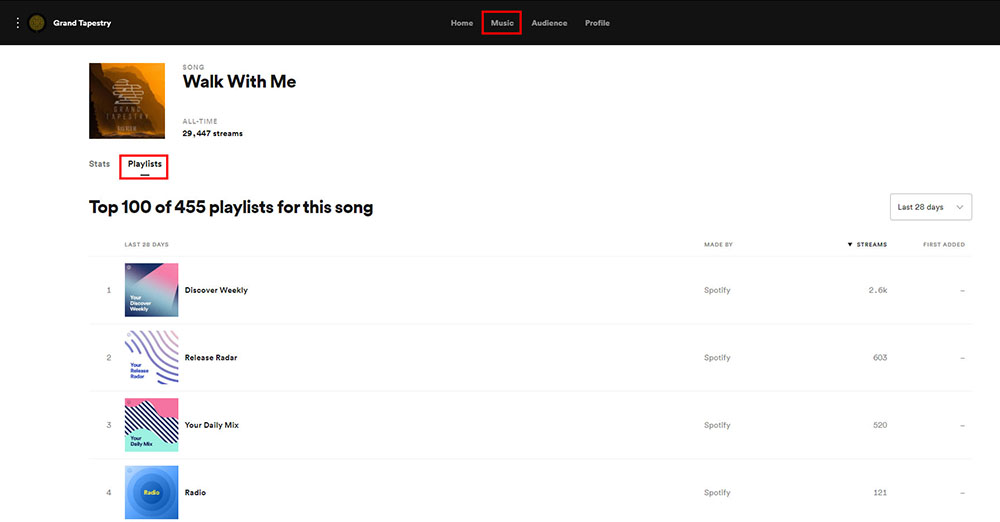
Advanced Playlist Tools (Paid)
Looking for my data and tools to help you with playlisting? Here are some other powerful tools that can help you:
- Monitor all the playlists your songs are on
- See what playlists other similar artists are on
- Find new potential playlists to pitch your songs to
- Access more relevant playlist and curator data to help you make better decisions
SpotOnTrack – They only offer a 14-day trial. Otherwise, you have to pay a pro or business plan to use.
PlaylistSupply – They charge $19.99 a month.
Chartmetric – You get a 7 day trial of a premium plan for signing up. They do offer a free basic plan with limited functionality.
Keep Expectations In Check
Getting your music on playlists can have a positive impact on your music career, but don’t expect miracles.
One of the biggest issues I’ve found with emerging artists is that desire to “make it” can easily be shadowed by impatience. This can lead to bad investment decisions around time and money. Expecting playlists will lead you to overnight success is going to actually lead to more disappointment.
There have been some stories over the years of how one song gets added to a popular playlist changed a musician’s life. Although it can happen, it’s very unlikely.
Don’t pay insane amounts of money for “successful” playlists just to be featured. In the long run, there is not much retribution for that.
Be aware that there are a lot of playlist factors to account for even if you do get placement:
What type of music or theme does the playlist curate? You don’t want to just throw your songs on any type of playlist. The other songs in the playlist matter and can affect your song’s performance on Spotify. Although the responsibility is on the playlister, adding a song that is out of place within the vibe of the playlist may lead to higher skip rates.
Are the playlist followers active? Is the playlist live with activity? If the playlist doesn’t have people listening to it or full of fake followers, placement is going to do anything for you.
How often does the playlist update? This is a sign of an active playlister which means the followers are more likely to be active and engaged.
How many songs are on the playlist? You may get added to a playlist with a bunch of followers, but if there are hundreds of songs and you’re at the bottom, you can’t expect action much from it.
Do you do background music? If you do a lot more instrumental/background music (i.e. study music), you might get streams but people rarely engage or investigate the artist for utility-based music.
Lastly, make sure to optimize your Spotify artist profile. If you have something special on a playlist, people will naturally stop to see who you are and want to learn more about you. To further build that fan relationship, make sure you make a good impression when they click on your profile.
New Spotify Features for Improving Discoverability (In Beta)
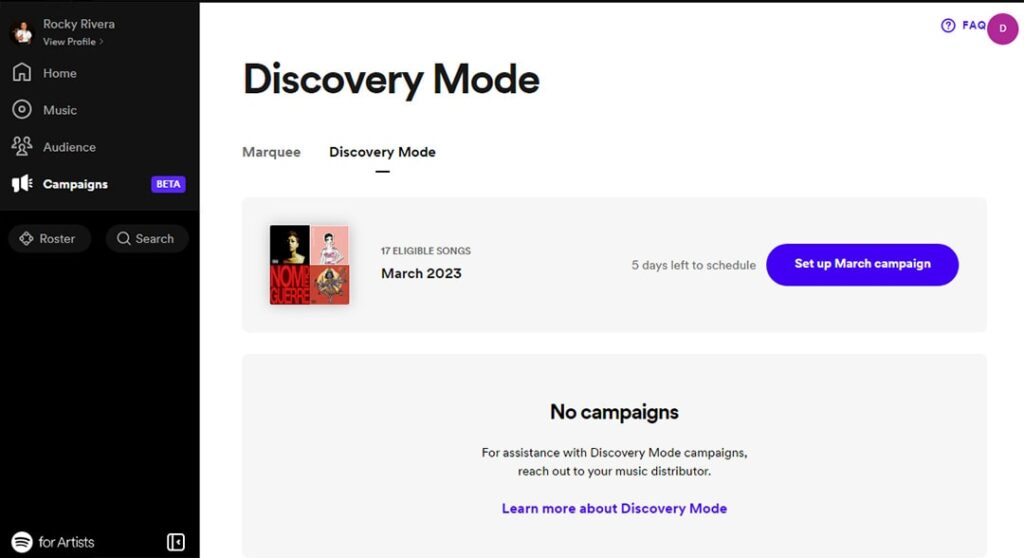
As of early 2023, Spotify is currently testing a new feature with select users called “Discovery Mode.” It’s a new marketing tool that helps artists gain new listeners, playlist adds and followers on Spotify at no upfront cost.
The way it works is you select a song from your catalog to create a Discovery Mode campaign and set a campaign length. During this campaign period, the Spotify algorithms will push your track to areas on Spotify that listeners are most open to discovery, which is currently Radio & Autoplay. According to Spotify, their statistical modeling shows that artists see on average +50% in saves, +44% in user playlist adds and +37% in follows during the first month of using Discovery Mode.

An artist I work with received early access to Discovery Mode
Instead of having to pay out of pocket, Spotify charges a 30% commission on the recording royalties generated from all streams in Radio and Autoplay of the song you selected. All other streams of the song in areas outside of Radio and Autoplay will be commission-free.
Although this feature is still in beta testing, it’s a nice feature to have if you’re looking for new fans and you don’t have a budget.
Conclusion
Spotify playlists provide many different discovery opportunities for you to get more exposure and new fans for your music. The different types of playlists on Spotify make it a more attractive streaming platform for musicians than its competitors.
Your best bet is to focus your energy on how to influence algorithmic playlists to push your songs to relevant listeners. Remember to leverage the save-to-listener rate and other engagement factors to help your song’s performance in Spotify’s algorithms. And of course, you should definitely take advantage of Spotify’s editorial playlist submissions since it’s free.
If you’re just starting out, your safest bet considering the time and cost is using a service like SubmitHub or Groover to get your songs on Spotify playlists.
Playlisting has its benefits as a discovery tool, but it shouldn’t be the only thing you use in your marketing/promotional efforts. Instead of paying hundreds of dollars for a playlist pitching service, I feel you can do way more with that money on Facebook or Instagram ads.
My Recommendation
If you have a few hundred to spend for promotion, create your own listener playlist and place your single on top. You can fill the other songs on the playlist with your own music and songs from other similar-sounding artists. Ideally, you want to choose songs from more popular artists who are more likely to share the same fans like you.
You can then drive traffic to this playlist through your ads to get people listening to these specific songs. This will do two things for you:
First, it will help you get followers for you and your playlist to establish a connection point for future releases.
Second, by placing your songs in playlists with other music similar to yours, Spotify uses this data to draw connections and better assess who would like your music. It is more likely that Spotify would recommend your music in their algorithmic playlists when a listener is a fan of these other similar artists.
Don’t forget to pin this playlist to the top of your artist profile with Artist’s Pick so it’s more visible. You can do this in Spotify for Artists by clicking on the ‘Profile’ tab.
Other Spotify Tips
- Getting to the chorus earlier or placing it at the beginning of the song since it’s what tends to hook listeners.
- Avoid uploading and pitching songs with very long intros. Consider breaking up the long intro into a separate track.
- Shorter songs are more optimal in today’s streaming world because a 2-minute song pays out the same as a 5-minute song. A stream is counted if a song is listened to for 30 seconds or more. This is not to say you should compromise artistry to intentionally make shorter songs either.
- Nothing wrong with explicit lyrics (make sure to properly label it when uploading to your distributor), but understand it can limit the playlist potential of your song.
- Don’t try to game the system by having people listen to one song on repeat as they will penalize.



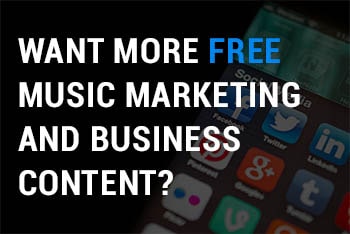
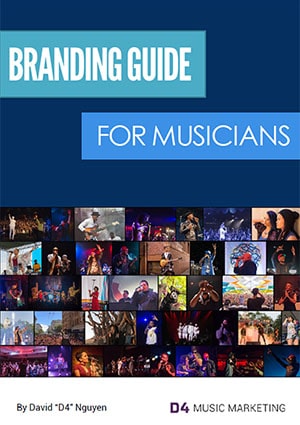

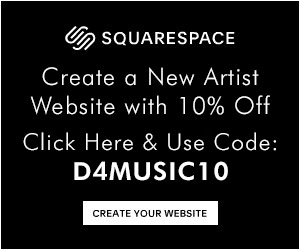

As a mom manager of a young adult artist “Siren” aka Sophia Lund…I value your experienced wisdom, valuable recommendations and overall willingness to share your acquired knowledge. I appreciate it so very much! When we are at the point of needing to hire a music marketing team, D4 Music will be who I will seek out to work with. This/your D4 checklist was my bible in releasing my daughters first debut single on Distrokid on May 20, 2022. I felt so fortunate to have found your checklist when dropping her first single. Thank you so much!!!!